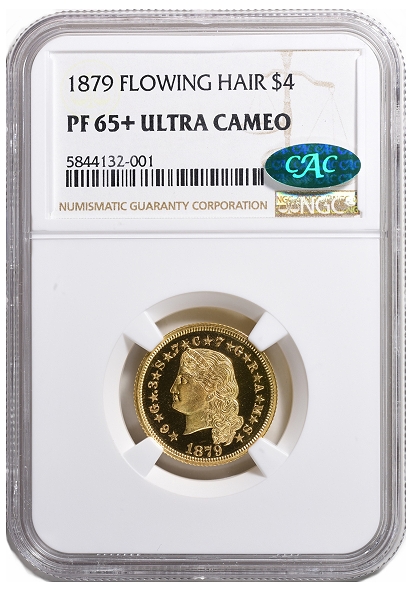Flowing Hair Stella by CoinWeek ….
On Sunday, April 26, bidding ends at GreatCollections.com for this 1879 $4 Gold Flowing Hair Stella, graded Proof-65+ Ultra Cameo by NGC and approved by CAC.
 NGC has graded 240 total examples of the 1879 Flowing Hair Stella (out of 425 originally minted), regardless of grade or designation. This specimen of the unique gold denomination is the only PF-65+ listed by NGC in their pop report, though there are a handful of coins that NGC has graded higher. The top pop coin is a lone PF-68, and the grading service lists three pieces at PF-66. Not that it matters much; according to available auction records, all Mint States Stellas graded by NGC–from 63 on up–are six-figure coins. Above 65, the only question is what the first digit is going to be.
NGC has graded 240 total examples of the 1879 Flowing Hair Stella (out of 425 originally minted), regardless of grade or designation. This specimen of the unique gold denomination is the only PF-65+ listed by NGC in their pop report, though there are a handful of coins that NGC has graded higher. The top pop coin is a lone PF-68, and the grading service lists three pieces at PF-66. Not that it matters much; according to available auction records, all Mint States Stellas graded by NGC–from 63 on up–are six-figure coins. Above 65, the only question is what the first digit is going to be.
Having said that, there are no records for a 65+. However, since CAC believes the coin is strong for its (Proof-65+) grade, a look at auction results for PF-66 could be useful. An example sold for $258,500 USD over six years ago in June 2013, and another one earned $253,000 in January 2012.
We can also look at Proof-65 examples, though all of these were certified by PCGS. The most recent sales of Proof-65 Ultra Cameo specimens hover at or above the 200K mark. One sold in March 2014 for $199,750 USD, and another sold four months earlier for $205,625. Going back several years, another example garnered $207,000 in August 2007, and yet another went for the same amount almost a year earlier in September 2006. February of that year saw a piece sell for $241,000, and in July 2005 an example sold for $231,000.
At the time of writing, the high bid for this NGC/CAC PF-65+ UC 1879 $4 Gold Flowing Hair Stella Proof is $157,500 after 43 bids.
If you want to check out GreatCollections for more information about prior sales, be sure to check out the GreatCollections Auction Archives, with records for over 600,000 certified coins the company has sold over the past seven years.
The $4 Gold Stella
In 1865, four Western European countries–France, Switzerland, Belgium and Italy–formed a treaty organization called the Latin Monetary Union. Almost 100 years before the Treaty of Rome began to lay the groundwork for the European Union, the Latin Monetary Union established a common monetary standard based on France’s gold franc in order to facilitate trade between member states. Other European countries joined the Union over time, and the idea was so attractive (or the market the Union represented was so important) that nations all around the world adopted the standards of the LMU for their own coinage.
After a couple of failed designs, the United States created a pattern coin matched closely to the Monetary Union standard. Thanks to the work of U.S. Ambassador to Austria John A. Kasson, whose experience with Austrian coinage inspired the strange denomination, the $4 Stella pattern was first struck at Philadelphia in 1879. Interestingly, the $4 gold coin contained $3.85 in metal–equivalent to that found in the Austrian eight florin.
The Mint’s Chief Engraver Charles Barber designed the first obverse, with Lady Liberty’s long hair loose around her neck; this is known as the “Flowing Hair” Stella. Assistant Engraver George T. Morgan (of Morgan dollar fame) designed the second obverse with Liberty’s hair on top of her head, known as the “Coiled Hair” Stella. Examples of both designs were produced in 1879 and 1880.
Perhaps one of the strangest elements of the coin is the inscription “★6★G★.3★S★.7★C★7★G★R★A★M★S★” on the obverse to show the pattern’s guaranteed gold content. The reverse features a large star with the inscriptions ONE STELLA and 400 CENTS inside of it, and the denomination FOUR DOL. beneath it. The legend UNITED STATES OF AMERICA arcs around the rim, and between it and the star are the mottos E PLURIBUS UNUM and DEO EST GLORIA, which translate to “Out of Many, One” and “To God is the Glory”.
The coin gets its name (as does the $4 denomination) from the star on the reverse, a design element employed because it is another aspect of national symbolism, like the bald eagle or a Union shield.
The patterns consist of an unusual alloy: 85.71% gold, 4.29% silver, and 10.00% copper. This, as well as the fact that the value of the coins the Stella was designed to be the American equivalent to would likely fluctuate and render the entire concept of the Stella moot, helped ensure that Congress would take a pass on the new coin. Still, 25 four-coin sets had been delivered to Congress on January 24, 1880 (the coins in this initial shipment were struck on the Mint’s medal press), and Congress ordered an additional 400 sets (struck on coin presses) in March. These were delivered on April 5.
An all-too-on-the-nose bawdy joke at the expense of the political class suggested that members of Congress gifted mistresses and prostitutes with the exotic coin, with many pieces ending up in jewelry worn by “ladies of the night”. While entertaining and full of “truthiness”, there is no proof of this having ever happened.
Even though it is technically a pattern coin, many if not most collectors of classic United States gold coins consider the Stella part of the “series”.




